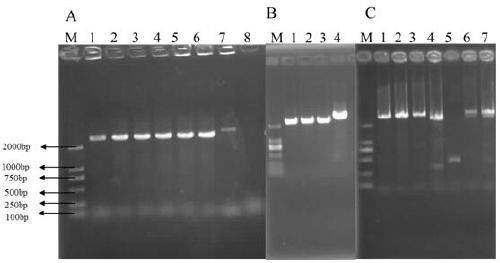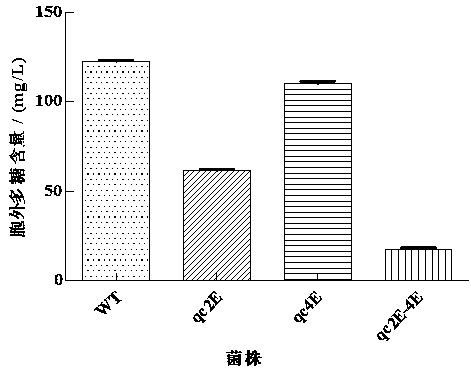Application of guided glycosyltransferase gene
A technology of glycosyltransferase and gene, applied in the field of gene function and application, can solve the problem of little research on the effect of culture condition transformation, and achieve the effect of improving screening efficiency
- Summary
- Abstract
- Description
- Claims
- Application Information
AI Technical Summary
Problems solved by technology
Method used
Image
Examples
Embodiment 1
[0031] Embodiment 1: guide glycosyltransferase gene ( cps 2E, cps 4E) Knockout homology arm clones
[0032] 1. PCR amplification of upstream and downstream homology arms
[0033] The genome of food-borne Lactobacillus plantarum YM 4-3 was extracted using the TAKARA Bacterial Genomic DNA Extraction Kit (Bao Biological Engineering Co., Ltd.), and the specific operation was carried out according to the kit instructions. targeting genes cps2E , using the extracted genome as a template, and up-2EF (CCG GAATTC TGAACAGATCG ATACTGGTG, the underline is the restriction site Eco RI), up-2ER (ACATTTCTCATCTGGCGCGTTTGTGGTTGTACATGAC) and down-2EF (GTCATGTACAACCACAAAACGCGCCAGATGAGAAATGT), down-2ER (CCC TCGAG CATT TTTGCGACTCTCAT, the underline is the restriction site xho Ⅰ) Amplify to obtain the upstream and downstream homology arms cps2E-up (1066bp) and cps2E-down (1048bp). targeting genes cps4E , using the extracted genome as a template, and the primer pair up-4EF (CCG GAATTC...
Embodiment 2
[0040] Example 2: cps 2E, cps 4E Gene Single Knockout Vector Construction
[0041] restriction endonuclease Eco RI, xho I and Eco RI, Hin d Ⅲ Carry out synchronous digestion of the sequenced correct gene knockout fragment and the temperature-sensitive plasmid pFED760 respectively. cps The 2E enzyme digestion system is: Eco RI, 2 µL; xho Ⅰ, 2 µL; 1×Hbuffer, 4 µL; gene knockout fragment or pFED760, 10-16 µL; add sterilized deionized water to 20 µL. cps The 4E enzyme digestion system is: Eco RI, 1 µL; Hin d Ⅲ, 1 µL; 1×M buffer, 4 µL; gene knockout fragment or pFED760, 30 µL; add sterilized deionized water to 40 µL. After digestion at 37°C for 4 h, the digested products were recovered. After adding samples according to the target gene:vector = 4:1-2:1 (molar ratio), T4 DNA ligase was added and ligated at 16°C for 12-16 h; Transformation method: Introduce the ligation product into Escherichia coli DH5α competent cells, and then spread it on the erythromycin-LB s...
Embodiment 3
[0042] Example 3: cps 2E, cps 4E Gene Single Knockout Strain Construction
[0043] 1, cps 2E, cps 4E gene knockout vector introduced into Lactobacillus plantarum competent cells
[0044] Prepare Lactobacillus plantarum competent cells according to the method reported by Fei Yongtao (2015, master's degree thesis of South China University of Technology); add 10 μL gene knockout vectors pFED760-Δcps2E and pFED760-Δcps4E to 90~100 μL Lactobacillus plantarum competent, gently Mix evenly, and transfer to the pre-cooled electric shock cup after 5 minutes of ice bath, and conduct electric shock according to the parameters of 12.5kv / cm, 200Ω; after the electric shock is completed, quickly add 900 μL of fresh MRS culture solution to the electric shock cup, and gently blow and mix with the tip of the pipette. After homogenization, the mixture was transferred to a sterile 1.5mL centrifuge tube, and incubated at 28°C for 2.5-3 h to recover the cells. After cultivation, the bacterial s...
PUM
 Login to View More
Login to View More Abstract
Description
Claims
Application Information
 Login to View More
Login to View More - R&D
- Intellectual Property
- Life Sciences
- Materials
- Tech Scout
- Unparalleled Data Quality
- Higher Quality Content
- 60% Fewer Hallucinations
Browse by: Latest US Patents, China's latest patents, Technical Efficacy Thesaurus, Application Domain, Technology Topic, Popular Technical Reports.
© 2025 PatSnap. All rights reserved.Legal|Privacy policy|Modern Slavery Act Transparency Statement|Sitemap|About US| Contact US: help@patsnap.com


